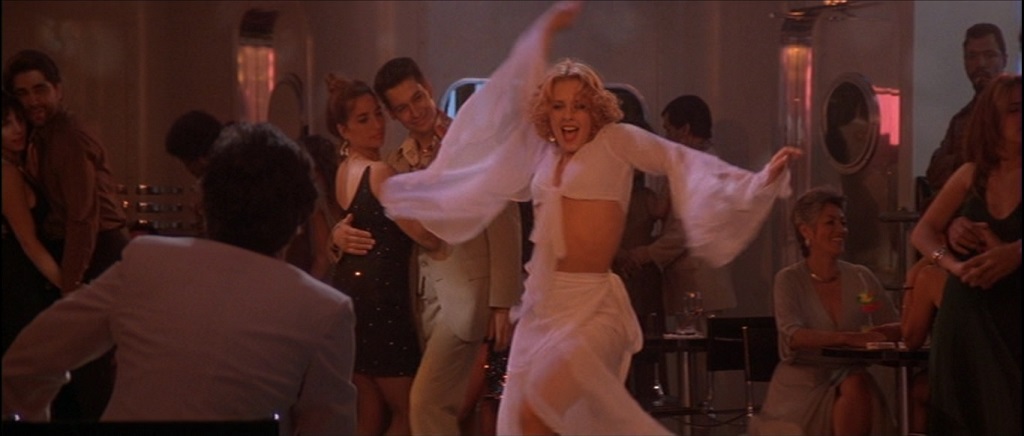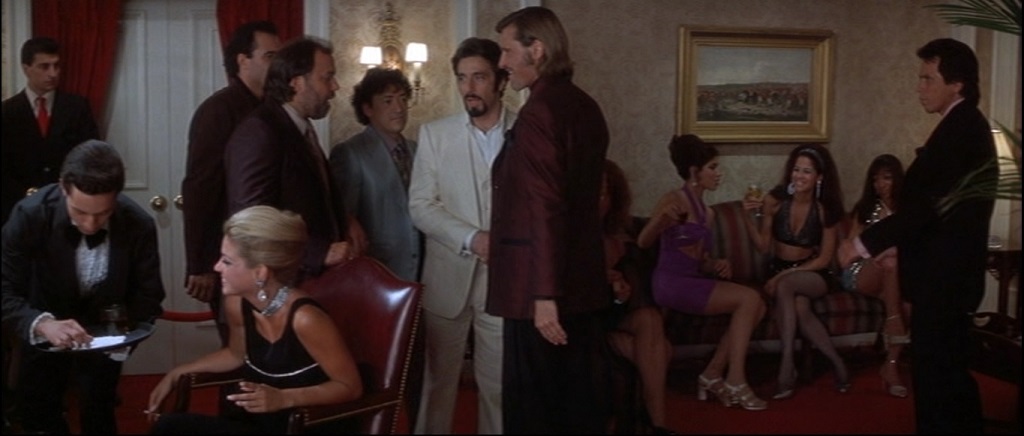Esmail broached the subject with music supervisor Maggie Phillips when she first interviewed for the job. She found the idea discomfiting. “People have licensed a score piece here or there, but there’s no real paper trail for older scores like there is for the other music we license,” said Phillips. “There was no way of estimating costs, at all, and the people we were licensing from wouldn’t even know. The NBC-Universal clearance team and my team, no one had ever done this before.” Still, Phillips took the job and it became an extensive research project to determine who owned the scores’ publishing rights, and then the actual recordings. Once that was determined, another journey began: locating the recording and digitizing it for the show. (While there might be obvious appeal in a “Homecoming” soundtrack comprised of the best thriller scores from the 20th century, that was a licensing bridge too far.)
Pre-existing scores meant tremendous time and expense. Sometimes Phillips discovered dead ends, or scores that couldn’t be licensed. Phillips and NBC-Universal also had to work with unions to make sure dozens of session players would be paid for scores they played decades ago. However, Phillips’ bigger concern became the creative side.
“Most editors are used to sending a scene to a composer, and having a composer hit those beats and write to those beats and emotional storylines to make it work,” said Phillips. “On ‘Homecoming,’ the editors, and our one music editor, had to to carve it out of preexisting score written for a different movie. We’d have to combine a few scores, and there were times I had to tell them to replace some scores, because they were too expensive after they had carefully crafted it to work with their scenes.”
As the first few episodes hit the editing room, Phillips and the editors started to see an even bigger creative problem. In the 10-episode series, there are longer, key scenes between Heidi (Julia Roberts), a counselor helping veterans adjust to everyday life, and Walter (Stephan James), a young soldier back from a tour in the Middle East. The show ultimately arcs around their many-layered relationship.
“It’s a weird tone between the two of them,” Phillips said. It’s slightly romantic, it’s a little emotional, but you don’t want to push it too hard. It should be pretty subtle, and the scores that we were using were really big scores… a lot of these things we found to put under those scenes felt very heavy handed.”
Often, published scores don’t include quiet moments of “underscore,” but rather the showy moments of action, drama, and emotion. Phillips started to doubt the feasibility of using entirely pre-existing scores.
“I called one of the producers and I was like, ‘I really don’t know if we’re going to be able to do this,’ and it was mostly because I was trying to help the editors find stuff for that first scene between Heidi and Walter,” said Phillips. “So they sat down and talked to Sam, I wasn’t there, and Sam was like, ‘Absolutely no. I want all pre-existing score.'”
Esmail recalled the moment he realized there was no turning back on his concept. “Music is everything to me,” said Esmail. “It’s the heart and soul of a movie or TV show to me because it can be such an injection of tone, and I think tone is everything to a story. So I just took a moment and said, ‘We should embrace this.’ This is too critical for me to ask someone to be derivative, which is also not very fair to them, but also, I wouldn’t want that. I would always constantly compare it to the real thing, and just thought it was so critical to the kind of tightrope walk that we’re doing with tone in the show that I just thought, ‘Let’s just go for it.'”
Phillips agrees that using older scores as temp music would have been a mistake. Music supervisors and composers refer to this as “temp love,” in which creators fall in love with the temp music and ask composers to mimic it. Like many, Phillips believes it’s not only a horrible way for a director to collaborate with a composer, but it’s also why so many scores in the last 15 years sound the same.
Phillips did get Esmail to use a few more modern scores for the show’s quieter moments. She also established a “No YouTube” rule for the editors: Not only were many scores pulled off the internet knock-offs that wouldn’t match, Phillips also wanted to secure the original recording before the editorial team started cutting to it.
Now that she has the final product, Phillips is impressed by how organic the music feels to the show, and the future possibilities for television scores.
“You don’t hear scores this big in TV, and it added so much of the tension,” said Phillips. “It’s a thriller, but it’s a slow burn. It’s not like you are wondering what’s behind the corner. The scores make it feel very thematic and heighten the tension and add to that edge-of-the-seat feeling you’re getting while you watch it. I don’t think it’d be like that without that big dramatic score on top of these scenes.”
So would she recommend using pre-existing score to other creators? “No,” laughed Phillips. “This ended up working because it was so organic to how Sam saw the show and shot the show. He’s a crazy genius, who was backed by a producing team willing to spend the money to see the process through.”
Below is list of the scores used in “Homecoming,” by episode.
Episode 1
“Dressed to Kill,” composer Pino Donaggio
“All The President’s Men,” composer David Shire
“Marathon Man,” composer Michael Small
“Vertigo,” composer Bernard Herrmann
Episode 2
“Klute,” composer Michael Small
“Duel,” composer Billy Goldenberg
“The Gift,” composers Daniel Bensi & Saunder Jurriaans
Episode 3
“Capricorn One,” composer Jerry Goldsmith
“The Andromeda Strain,” composer Gil Mellé
“The Car,” composer Leonard Rosenman
“Chariots of Fire,” composer Vangelis
“Gray Lady Down,” composer Jerry Fielding
“Star Chamber,” composer Michael Small
Episode 4
“The Amityville Horror,” composer Lalo Schifrin
“The Day The Earth Stood Still,” composer Bernard Herrmann
“The Hand,” composer James Horner
“Carrie,” composer Pino Donaggio
“The Andromeda Strain,” composer Gil Mellé
“L’Apocalypse des animaux,” composer Vangelis
“All The President’s Men,” composer David Shire
Episode 5
“Body Double,” composer Pino Donaggio
“The Taking of Pelham 123,” composer David Shire
“The Conversation,” composer David Shire
“Escape from New York,” composer John Carpenter & Alan Howarth
“The Thing,” composer Ennio Morricone
“Narrow Margin,” composer Bruce Broughton
“The French Connection,” composer Don Ellis
Episode 6
“High-Rise,” composer Clint Mansell
“Scanners,” composer Howard Shore
“The List of Adrian Messenger,” composer Jerry Goldsmith
“Copycat,” composer Christopher Young
“Creation,” composer Christopher Young
“Three Days of the Condor,” composer Dave Grusin
Episode 7
“Gray Lady Down,” composer Jerry Fielding
“The Thing,” composer Ennio Morricone
“The Andromeda Strain” (TV Series), composer Joel J. Richard
“Christine,” composer John Carpenter & Alan Howarth
“The Parallax View,” composer Michael Small
“The Thing,” composer Ennio Morricone
“The Fog,” composer John Carpenter
“Halloween 3,” composer John Carpenter & Alan Howarth
Episode 8
“The Conversation,” composer David Shire
“Christine,” composer John Carpenter & Alan Howarth
“Halloween 3,” composer John Carpenter & Alan Howarth
“Altered States,” composer John Corigliano
“The Andromeda Strain,” composer Gil Mellé
“The Fog,” composer John Carpenter
Episode 9
“Body Heat,” composer John Barry
“Dove Siete? Io Sono Qui,” composer Pino Donaggio
“Raising Cain,” composer Pino Donaggio
“Legend,” composer Tangerine Dream
“Oblivion,” composer Anthony Gonzalez & Joseph Trapanese
“All The President’s Men,” composer Michael Small
“The Eiger Sanction,” composer John Williams
Episode 10
 Moviefone's Phil Pirrello asks Christopher McQuarrie how he selects which clips to use in the opening titles of his two Mission: Impossible movies. "That's a really good question," McQuarrie responds. "If you look at the first Mission: Impossible -- Brian De Palma's -- he shows you every one of the characters that dies in the movie, in the order in which they die."
Moviefone's Phil Pirrello asks Christopher McQuarrie how he selects which clips to use in the opening titles of his two Mission: Impossible movies. "That's a really good question," McQuarrie responds. "If you look at the first Mission: Impossible -- Brian De Palma's -- he shows you every one of the characters that dies in the movie, in the order in which they die."



 Something about Hans-Christoph Blumenberg's Rotwang muß weg! (1994) must have impressed Brian De Palma, because he agreed to appear in the German satire, billed in the credits as the "famous American movie director." The film itself has always been hard-to-find, but I located the images included in this post at
Something about Hans-Christoph Blumenberg's Rotwang muß weg! (1994) must have impressed Brian De Palma, because he agreed to appear in the German satire, billed in the credits as the "famous American movie director." The film itself has always been hard-to-find, but I located the images included in this post at 




 Brian De Palma has cited the dream sequence in Roman Polanski's adaptation of Ira Levin's Rosemary's Baby as the key inspiration for the exposition sequence in Sisters. One can imagine De Palma's enthusiasm when, soon after, a producer (Edgar J. Sherick) let him read the screenplay for another Levin adaptation, The Stepford Wives, with hopes of De Palma directing. The screenplay was written by William Goldman, who, sadly,
Brian De Palma has cited the dream sequence in Roman Polanski's adaptation of Ira Levin's Rosemary's Baby as the key inspiration for the exposition sequence in Sisters. One can imagine De Palma's enthusiasm when, soon after, a producer (Edgar J. Sherick) let him read the screenplay for another Levin adaptation, The Stepford Wives, with hopes of De Palma directing. The screenplay was written by William Goldman, who, sadly, 
 At last month's Rome Film Festival premiere of his new movie, The Girl in the Spider’s Web, Uruguayan director Fede Álvarez brought up Alfred Hitchcock and Brian De Palma as key inspirations for him as a filmmaker (his previous features are the Evil Dead remake and Don't Breathe). According to
At last month's Rome Film Festival premiere of his new movie, The Girl in the Spider’s Web, Uruguayan director Fede Álvarez brought up Alfred Hitchcock and Brian De Palma as key inspirations for him as a filmmaker (his previous features are the Evil Dead remake and Don't Breathe). According to 




























